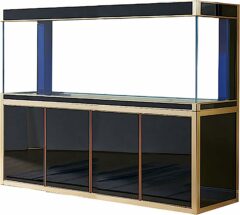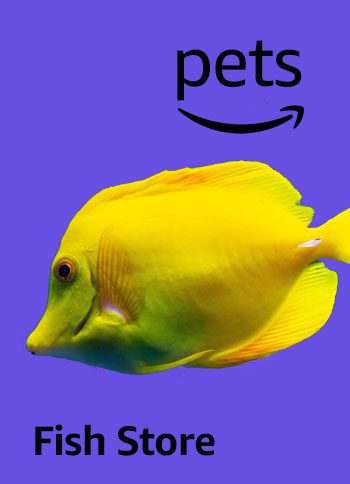Five Reef-Safe Algae Eaters
Do you have a reef tank? If you do, you probably know how annoying algae can be. Algae can make your tank look dirty, smelly and ugly. It can also harm your corals and other tank inhabitants by taking away their nutrients, light and space.
But don’t worry; there is a solution. You can add some reef-safe algae eaters to your tank. These are animals that love to munch on algae without bothering your corals or other tank mates. They can help you keep your tank clean and beautiful while adding fun and variety to your aquarium.
But not all algae eaters are reef safe. Some of them can be aggressive, destructive or picky.
In this article, we'll highlight the top five reef-safe algae eaters you can consider for your marine tank. We'll also give you some tips on how to care for them and what to feed them, besides algae, of course.
1. Lawnmower Blenny
The lawnmower blenny is a favorite saltwater, algae eater. They are also called the jeweled blenny, rock skipper or sailfin blenny. They have a brownish body with dark spots and stripes, a big head with funny eyes and a goofy expression.
The lawnmower blenny grows to about five inches long and needs at least a 30-gallon tank with lots of live rock and hiding places. They are a friendly and hardy fish that get along well with most tank mates, except for other blennies or fish that look like them.
The lawnmower blenny is crazy about algae, especially green hair algae and filamentous algae. They will spend most of their time grazing on the rocks and glass in your tank, keeping them clean and free of nasty algae. But you should also give them other foods, like spirulina flakes, pellets or frozen foods.
2. Emerald Crab
The emerald crab is a cute, small crab that can help you control algae in your reef tank. This crab has a bright green body with black tips on their claws and legs. Emerald crabs grow to be about two inches long and can live in tanks as small as 10 gallons.
The emerald crab is a scavenger that will eat almost anything they can find in your tank, like detritus, uneaten food and dead stuff. But they are especially good at eating bubble algae, which is one of the most challenging types of algae to get rid of. Emerald crabs also eat other types of algae, like green hair algae, red slime algae or coralline algae.
The emerald crab is usually reef-safe and peaceful, but they can be mean or hungry if they don't have enough food or space. So, you should give them enough food and room, and do not keep these crabs with very small or delicate fish or invertebrates. It would be best to provide some hiding places for your crabs, like caves, crevices or shells.
3. Yellow Tang
The yellow tang is one of the hobby’s most beautiful and popular, saltwater fish. They have a bright, yellow body with a white spine and a black tail fin. This fish grows to about eight inches long and needs at least a 75-gallon tank with lots of swimming space and live rock to move around.
The yellow tang is a plant-eating fish that primarily eats algae in the wild. They will graze on the rocks and glass in your tank, eating different types of algae, like brown algae, green algae, red algae or coralline algae. They will also help stop algae outbreaks by eating spores or bits that may float around in the water.
The yellow tang is a peaceful and active fish that can add a lot of color and movement to your reef tank. But they can be bossy towards other tangs or fish that look like them, so you should keep only one yellow tang per tank or add them simultaneously if you want to keep more than one. You should also give them other foods rich in plant matter, like seaweed sheets, spirulina flakes or pellets.
4. Quoyi Parrotfish
The quoyi parrotfish is a big and colorful fish that can be a great addition to your reef tank if you have enough space and money. They have a greenish-blue body with yellow spots and stripes and a unique beak-like mouth that they use to scrape algae off the rocks.
The quoyi parrotfish grows to about 12 inches long and needs at least a 180-gallon tank with lots of live rock and hiding places. They are a hungry algae eater that will eat almost any type of algae in your tank, like green algae, brown algae, red algae or coralline algae. They will also make a lot of sand due to their their unique way of eating, which can add to the available calcium and substrate in your tank.
The quoyi parrotfish is a peaceful and shy fish that gets along well with most tank mates, except for other parrotfish or fish that look like them. But they can be sensitive to water quality and prone to diseases, so you must keep your tank clean and stable. You should also give the quoyi parrotfish it other foods, like frozen foods, pellets or flakes.
5. Cerith Snails
Cerith snails are tiny and tough snails that can help you keep your reef tank clean and algae-free. They have brown or black shells with white or yellow stripes or spots. Their full size is only one-inch in length and can live in tanks as small as five gallons.
These snails are scavengers that will eat almost anything they can find in your tank, like detritus, uneaten food, dead stuff and algae. But they are especially good at eating diatoms, a type of brown algae that often appear on the substrate or glass in new or unbalanced tanks. They’ll also eat other algae, like green hair algae, red slime algae or coralline algae.
The cerith snail is reef-safe and peaceful and won’t hurt your corals or other tank inhabitants. They also stay swamped, constantly moving around your tank, cleaning every surface they touch. But they may be eaten by some fish or crabs, so you should give them some protection, like rocks, plants or shells.
Algae’s Role in the Aquarium Ecosystem
Algae might seem like a nuisance in your aquarium, but they actually play a vital role in creating balance and harmony in your aquatic ecosystem. Algae are a diverse group of photosynthetic organisms that can convert water and carbon dioxide into sugar and oxygen. They’re not plants, but they’re similar in many ways.
That’s why it’s important to have some natural algae eaters in your aquarium to help you control and prevent algae growth. They can help you keep your aquarium clean and healthy, while preserving the balance needed to allow your reef to thrive.





